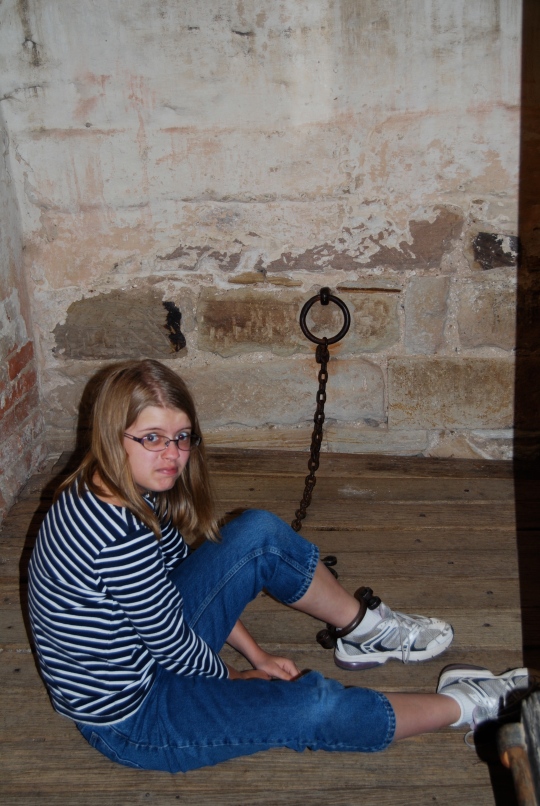We knew Australia was largely settled by the British as a penal colony, but did not really know much about that part of their history. In researching things to do on the island of Tasmania, we found several historic sites associated with their convict history. They even have a “Convict Trail” you can spend days following to learn more. Although I would have gladly followed the trail from start to finish, my family has less passion for history, so we narrowed our list.
Hobart has the Female Factory Convict site where female convicts were taken. We saw the Richmond Gaol and the Port Arthur Prison and visited a large farm in northern Tasmania, which operated using convict labor for several years. Life as a convict in Australia was harsh with poor living conditions, diet and medical care. Once in these facilities, they were only called by an assigned number, never by name and conversation was against the rules. You might think that as a convict, they did not deserve the best treatment. Although true convicts were sent to Australia, not all were hardened criminals that deserved harsh treatment.

The Female Factory. When it operated, this yard contained buildings with three different types of convict cells, a hospital, nursery and chapel.
The Female Factory Convict site was an expansive complex that was enlarged several times to meet the growing female convict population and, in some cases, improve the conditions. The females brought here carried convictions, but in many cases, could hardly be considered serious criminals since their convictions included vagrancy and petty theft. The historic site is a small portion of what it once was and is mostly ruins. Our tour included a slight immersion experience where we were “convicts” along with a young woman there. They were somewhat “gentler” in their portrayal since Jenna was in the group. She got to ring the bell that signaled the activities during their day. I kept expecting the overseer to ask David why HE was at the Female Factory.
Convicts could be sent to settlers’ homes and farms as free labor. Women from the Female Factory were used as domestics. Men worked as farm labor. The settlers had to provide shelter, food, clothing, the basic necessities. However, they did not have to pay the convicts, so it was pretty cheap labor, a financial benefit, especially on large farms. The Archer farm operated on convict labor until the 1840s. Mr. Archer even built a beautiful brick chapel for their religious training. Not all owners treated the convicts fairly, however, and the government ended this practice in the 1840s. The farm remains in private hands as a working farm, but is open for tours.
 The Richmond Gaol was the most intact of the prison facilities we saw. Built in stages between 1825 and 1840, it included cells for men, women and solitary confinement. It was used for local lock-up from 1877 to 1928. We locked Laura in leg irons, but Jenna was less enthused about that particular experience.
The Richmond Gaol was the most intact of the prison facilities we saw. Built in stages between 1825 and 1840, it included cells for men, women and solitary confinement. It was used for local lock-up from 1877 to 1928. We locked Laura in leg irons, but Jenna was less enthused about that particular experience.

Ruins of the penitentiary at Port Arthur. After being gutted by fire in 1897, it lay in ruins until conservation work in the 1960s. The building also contained a library, chapel and mess hall.
The Port Arthur site was incredibly fascinating. The extensive property retains its layout as a town and includes military facilities for the soldiers, homes for settlers, and ruins of many structures, including the convict facilities. After the prison closed, lots and buildings in Port Arthur were sold off and it functioned as a typical town. The prison facilities were used for other purposes for a period of time, but in the 1890s, brush fires damaged or destroyed several buildings. The area is now an historic site interpreted as a penal colony. Our afternoon there was informative, but quite wet as a storm moved through. I convinced Jenna to try-out a cell, but she was not too keen on being in there.

Interpreted ruins of the Separate Prison at Port Arthur. The facility had a chapel and the convicts were all kept in solitary confinement in hopes they would benefit from the silence and separation.
For me, the history was fascinating. It was equally interesting to see the Australians’ preservation, restoration and interpretation methods. So many of their former prison facilities fell into decay and ruin, due to lack of funds and in some cases, a desire to ignore or hide that part of their heritage. For many years, descendants of convicts did not acknowledge that. Many buildings at the Female Factory were intentionally demolished. Today, historians have “made lemonade”. They have taken the ruins, preserved, restored, reinforced, repaired, etc. and are interpreting what they have. Ruins without roofs, floor and some walls, remain with stabilization so visitors can walk through. Selective reconstruction provides a sense of space in the various structures. Their interpretation includes not only its original history, but also the years of neglect and decay.

Interpreting the Penitentiary ruins at Port Arthur. The walls are stabilized and visitors can walk through on both the 1st and 2nd floors.
Although I certainly could have spent much more time exploring and delving into this part of Australia’s history, the places we visited and things we saw were informative and interesting, not only for their historical value, but for their methods of preservation and interpretation.






Leave a comment